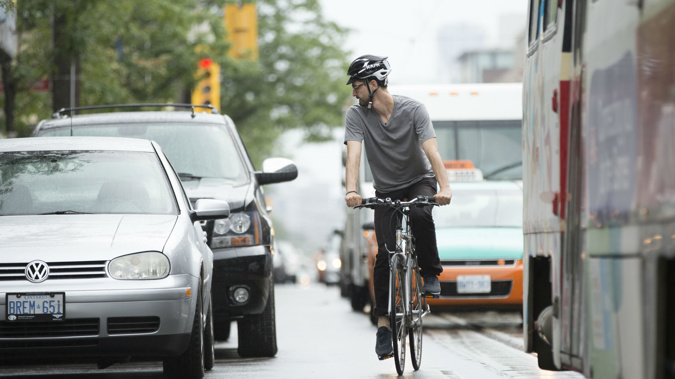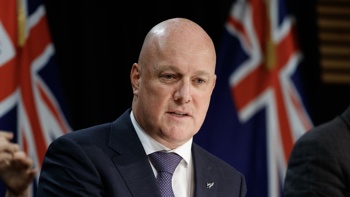
Like many things, cycling in Auckland doesn't attract quite the same level of mouth-frothing rage as it does in London. I'm discounting social media in saying that, of course, but I don't think we have the equivalent of Father Michael Dunne of Chiswick.
Father Michael, not content with using Praying the Rosary to ask that a proposed cycleway be turned away from his church, also declared that the cycleway in question would "do more damage than the Luftwaffe". That's right, cycle lanes, even though they save lives, do more damage than bombs.
Nigel Lawson, the former chancellor of the exchequer, probably thought he was being admirably restrained when he pontificated from the House of Lords that some cycleways "are doing more damage to London than almost anything since the Blitz". Subtly different? Nope, he was just spouting the same offensively loony idea. Lawson is also a leading climate-change denier.
If you're wondering what exactly the relative damage of cycle lanes and the bombing of Britain during World War II might be, the answer is: the Blitz killed 32,000 people and destroyed two million homes. Cycle lanes, at their worst, discombobulate some citizens in search of a car park.
Critics here tend to keep their ranting to the claim that no one wants cycle lanes, no one uses them, cyclists are dangerous road users and so on. And meanwhile, cyclist Alexander Ray remains in an induced coma in hospital with swelling on his brain, after being hit by a car at the intersection of New North Rd and Morningside Drive on Wednesday. His jaw was dislodged from his skull, his chin fractured and his right eye socket smashed.
It's not yet known how the crash happened, but whatever the cause, the outcome was the same as always: the car driver didn't get hurt but the bike rider did. No one deserves to be hospitalised with life-threatening injuries.
Cars are dangerous. It's why we need cycle lanes.
It's also why those commentators who keep smugly stirring up a general fury about cyclists are themselves dangerous. When you demonise people, you dehumanise them. And that makes it easier for others to forget to take care.
Back to London for a moment. It's not obviously a cycling city, but in recent years, Father Michael and Lord Poobah notwithstanding, public support has enabled the widespread growth of a cycle lane network. Londoners have consistently asked for more.
The result: half a million people in that city now cycle every day. Aha, say the critics, that's only 5 per cent of the population. True. And if you took that 5 per cent off their bikes and put them in cars, they'd stretch back nose to tail for 1000 kilometres. If you put them on the Tube, they'd fill 97 trains. Not carriages, whole trains.
Despite rapid population growth, there are now fewer cars in central London than there were five years ago. Congestion charges and cycling, take a bow. It's just preposterous that a city as big and snarled up as that city has traditionally been can make such progress, while the deniers here fret themselves silly about how cycling will never work.
March was a big month for cycling in Auckland. Not London-big, obviously, but Auckland-big. According to automatic counters set up around town there were 193,530 cycle trips into the city centre last month, up 11.8 per cent on March a year ago. Around the rest of Auckland there were 184,810 trips, an increase of 7.3 per cent. These are solid rises.
We also know that in 2017, a remarkable 35 per cent of Aucklanders got on a bike. Not every day, but from time to time. We are all – well, a third of us and growing – cyclists now.
Even on last year's figures, Aucklanders averaged 10,055 bike trips per day. If you put all those people in cars at the average occupancy rate of 1.4 per car, the line would stretch for 32km.
The more cycle lanes that get built, the more people are cycling. The Waterview Shared Path opened in October last year, connecting Mt Albert to the Northwest cycleway at Waterview. It's a commuter route but it's even busier at weekends: if you're looking for a scenic ride, check out the very lovely Meola Creek.
Auckland Transport has 29 more cycling projects listed on its website that are either being built now or are proposed for the near future. The focus is the central city and nearby suburbs, because that way they create a network, rather than single isolated lanes, which is more useful to more people. Over time, the network keeps expanding.
But it's not just the centre. Planning, consultation and/or construction are also underway on major cycling projects in Glen Innes, Tamaki Drive, Albany, Northcote, New Lynn, Te Atatu, Panmure, Pakuranga, Papakura, Takanini and Mangere.
One of the most exciting approaches involves the Safe Routes projects. In Mr Roskill, for example, footpaths on the streets around schools and parks have been widened and crossings made safer, so kids can ride bikes to school and to recreation areas without having to risk their lives on the roads.
Backing that up, May Road School in Mt Roskill has become the 30th school in Auckland to join Bikes in Schools. This initiative organises bike skills training and also helps provide bikes for kids.
At some point, we'll reach a tipping point. Whole school communities with those new Safe Routes will embrace cycling. E-bikes will become cheap enough to appeal to exponentially more people. The pleasures of riding, in safe lanes, with others, will become intoxicating.
And, as in central London, because of the great number of cyclists it will even be easier, if this is what you want or need to do, to drive a car around.
Take your Radio, Podcasts and Music with you









